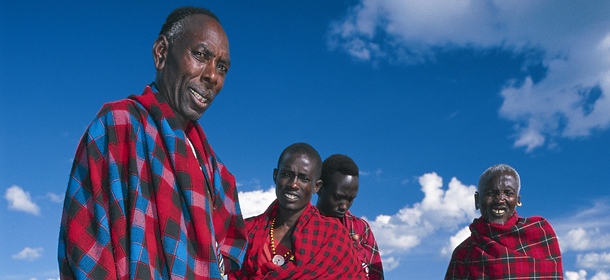The Maasai or Masai people are the best known tribe in East Africa and probably one of the most recognisable in the world. They are a semi-nomadic people located in Tanzania and Kenya although they originated in Sudan. They are a friendly and welcoming tribe who live near many of the famous game reserves in East Africa and they can be visited in their villages so that you can experience their traditional way of life including dances, ceremonies, herding and sometimes even a Maasai wedding!
There are an estimated 840,000 Maasai in Kenya and around 430, 000 in Tanzania (from the 2009 census) and the numbers are growing every year. However with the horrendous droughts in the Horn of Africa and northern Kenya their livestock and lifestyle are being threatened. They in the past been lauded for their successes in surviving in such a harsh desert environment and they still battle on, determined to continue their way of life despite all the natural disasters that befall them.
The Maasai are “pastoralists” which means their main farming is based on nomadic herding of cattle and goats and moving their livestock to where the water and grazing can be found. You will often see them if you travel on safari as they have a freedom of movement throughout many of the national parks and game reserves. In fact they also own and successfully manage several game lodges and game reserves on their traditional lands. However this is a sad reflection on the days before the English arrived when they owned vast tracts of prime grazing areas rich with wildlife and game. When the English arrived to colonise Kenya they took 60% of the Maasai’s land leaving them with much smaller areas without the rich grazing. The land was then passed on to white ranchers and farmers. This has forced many Maasai to settle down farm the land for subsistence crops such as maize. A herd of cows needs a very large area for grazing and many Maasai no longer have access or ownership to the necessary amount of land to continue their traditional way of life. The traditional Maasai diet was cow’s milk, blood and meat but as they gradually move towards farming crops this is being replaced with milk and a maize based porridge.
The Maasai have a rich culture and are instantly recognisable from their traditional dress. Both men and women wear the long cloth wrap known as the shuka which covers one shoulder, red being the favourite colour. Women dress like the menfolk but they are also usually adorned with huge amounts of beautiful handmade beading and other jewellery. Ear piercing and lobe stretching are also traditional forms of body adornment. Head shaving is an important ceremony for both sexes as they pass through different stages of their lives. Children are not named until they reach the age of three (due to the high infant mortality rate they have suffered from) when they also get their heads shaved save for a small tuft on top known as a cockade. Even a bride-to-be gets her head shaved as a rite of passage! They also celebrate many events and rites of passage with music in the form of singing and dancing with their traditional adumu (jumping into the air). The biggest ceremony is the 10 day long Eunoto, the warrior’s coming of age ceremony, which involves much singing and dancing (and flirting!).
